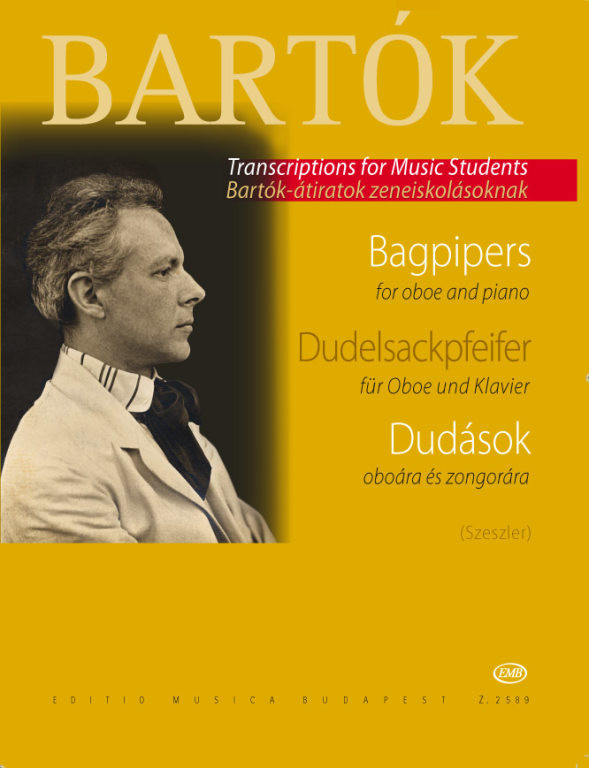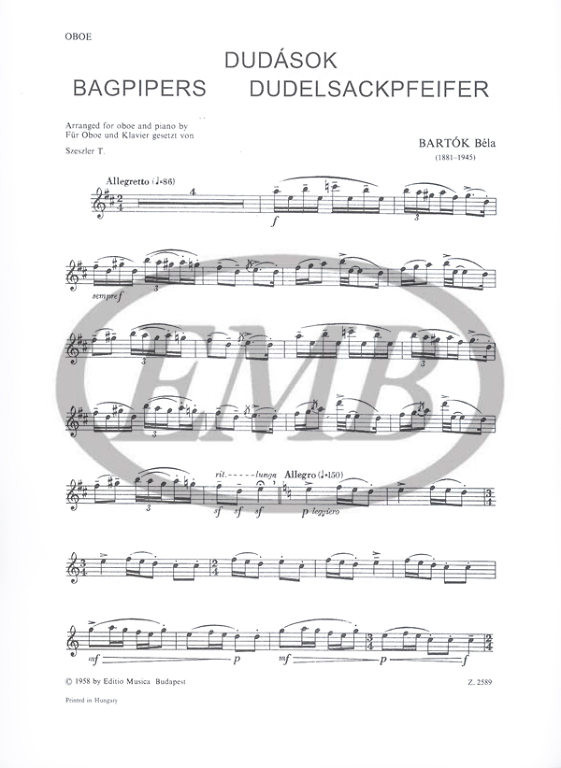Description
Bartók Béla: Bagpipers | Dudások – Transcribed by Szeszler Tibor (Music Score)
Product Information
- ISMN: 9790080025895 / 979-0080025895
- Item Number: 2589
- Product Type: Paperback
- Title: Bartók Béla: Bagpipers / Dudások
- Edition: Transcribed by Szeszler Tibor
- Setting: Oboe and Piano
- Series: Bartók Transcriptions for Music Students
- Period: 20th Century
- Languages: English, German
- Length: 10 pages
- Format: Bach (23 x 30,2 cm)
- Weight: 0.063 kg
- Published: 1958
- Publisher: Editio Musica Budapest Zeneműkiadó
- Made in: Hungary
Overview
"Bagpipers" is the first movement of the three-movement Sonatina composed in 1915. The original conception of the Sonatina involved a group of Romanian folk dances for piano; Bartók selected three parts from this project, naming them as the Sonatina. The first movement, "Bagpipers," features two distinct dances intended to be performed by two bagpipers. Its thematic material is rooted in a couple dance from Transylvania—the ardeleana (also known as the kanászos)—with its middle section inspired by the bagpipe playing of a middle-aged man recorded by Bartók in Váncsfalva (now Oncesti) of Bihar County in February 1910. In 1931, Bartók orchestrated the piece for symphony orchestra under the title Dances from Transylvania. This transcription for oboe and piano was prepared by the Liszt Prize-winning oboist Szeszler Tibor (1919–1992).
Hungarian Translation – Overview (Áttekintés)
A Dudások az 1915-ben zongorára komponált Szonatina című háromtétel első tétele. Eredetileg román néptánccsokrot tervezett zongorára Bartók, melyből három részt válogatott össze és nevezett el Szonatinának. Az első tétel, a Dudások, két táncból áll, melyet két dudás előadására írt. A darab alapját egy erdélyi páros tánc, az ardeleana (kanászos néven is ismert) képezi, míg középrészét egy középkorú férfi dudajátéka ihlette, melyet Bartók 1910 februárjában rögzített Bihar megye Váncsfalvában. 1931-ben a zeneszerző nagyzenekarra is meghangszerelte a művet Erdélyi táncok címmel. A jelen átiratot oboára és zongorára Szeszler Tibor, a Liszt-díjas oboaművész készítette el.
Product Features
- Didactic Resource:
- Part of the Bartók Transcriptions for Music Students series, designed to support educational and performance purposes.
- A concise work of 10 pages ideal for introducing students to Bartók’s innovative treatment of folk material.
- Instrumental Setting:
- Arranged specifically for oboe and piano, offering a rendition that interprets the characteristic timbre of bagpipes through the oboe.
- Compact Format:
- Presented in Bach format (23 x 30,2 cm), making it a practical and portable addition to any music student's library.
- Editorial Excellence:
- The transcription, carried out by Szeszler Tibor, preserves the crucial stylistic and rhythmic nuances of Bartók’s original conception.
Interesting Facts
-
Historical Context:
The movement "Bagpipers" reflects Bartók’s original plan of a Romanian folk dance ensemble for piano, later distilled into the three-movement Sonatina. Its thematic reliance on Transylvanian dance rhythms offers insight into the composer’s connection with regional folk traditions. -
Transcription Adaptation:
In 1931, Bartók reworked the material for symphony orchestra under the title Dances from Transylvania, illustrating the versatility and enduring appeal of the music. Szeszler Tibor’s transcription for oboe and piano adapts these ideas in a unique setting suitable for music students. -
Inspirational Source:
The middle section of "Bagpipers" drew inspiration from a real-life recording of a middle-aged man's bagpipe performance in Váncsfalva, a testament to Bartók’s commitment to authentic folk expression.
Hungarian Translation – Interesting Facts (Érdekességek)
-
Történelmi Összefüggés:
A Dudások tétel tükrözi Bartók eredeti elképzelését, melynek alapját román néptánccsokor képezte. A darab transzylván táncritmusán keresztül betekintést nyújt a zeneszerző erdélyi népzenéhez való viszonyába. -
Átirati Kifinomultság:
1931-ben Bartók nagyzenekarra is meghangszerelte a témát Erdélyi táncok címmel, amely a darab sokoldalúságát és időtállóságát mutatja. Szeszler Tibor átirata oboára és zongorára egyedi előadásmódot kínál, amely kiválóan alkalmas zeneiskolások számára. -
Inspiráció Forrása:
A mű középrészét egy középkorú férfi dudajátéka ihlette, melyet Bartók 1910-ben Váncsfalván rögzített, ezáltal hiteles kapcsolatot teremtve a népi zenei elemekkel.
Publishers
Published by Editio Musica Budapest Zeneműkiadó in 1958, Bartók Béla: Bagpipers/Dudások is an essential resource in the Bartók Transcriptions for Music Students series, offering a unique interpretation of the Sonatina’s first movement for oboe and piano.
We value your feedback! Share your experience with this product to help others make informed decisions. Your review is important to us!
Hashtags
English:
#BartokBagpipers #Dudások #BartokTranscriptions #MusicStudents #OboeAndPiano #EditioMusicaBudapest #20thCenturyMusic #FolkInspired
German (Címkék):
#BartokBagpipers #Dudások #BartokÜbertragungen #Musikschüler #OboeUndKlavier #EditioMusicaBudapest #MusikDes20Jahrhunderts #VolksinspirierteMusik














